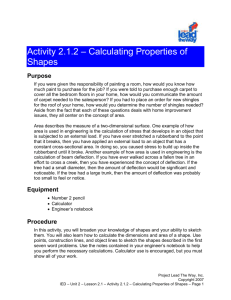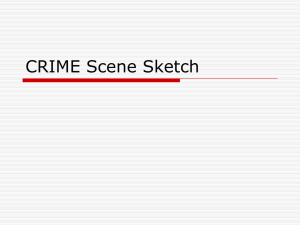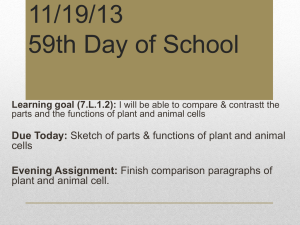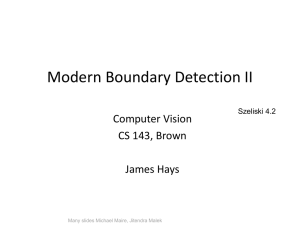Activity 2.1.2:Calculating Properties of Shapes
advertisement
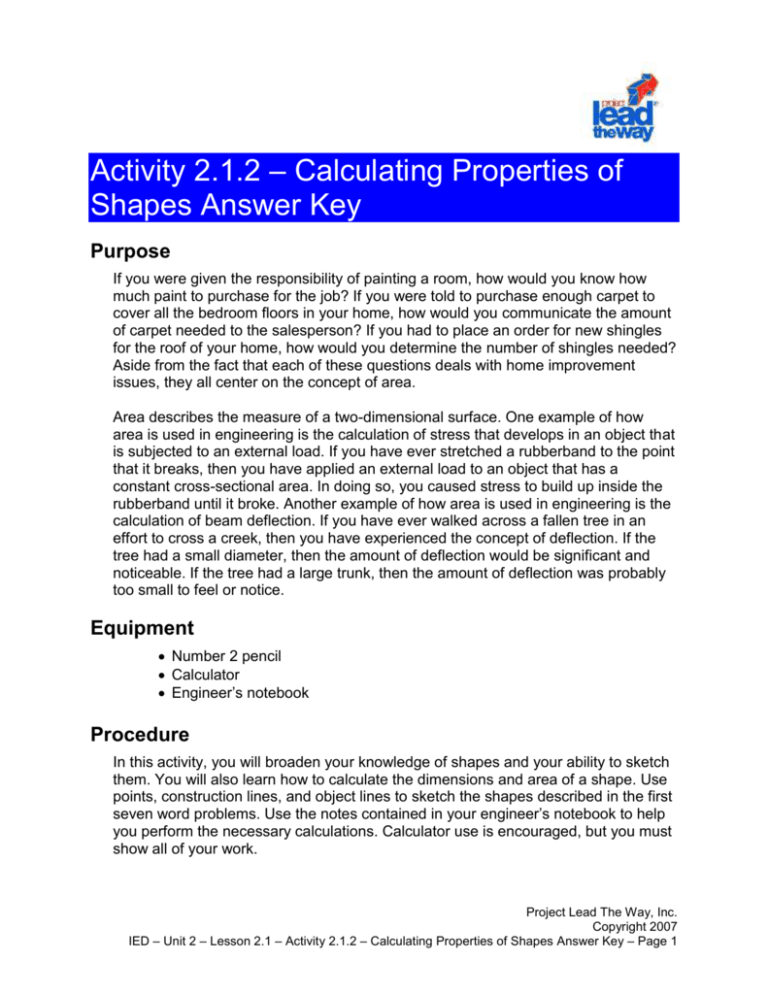
Activity 2.1.2 – Calculating Properties of Shapes Answer Key Purpose If you were given the responsibility of painting a room, how would you know how much paint to purchase for the job? If you were told to purchase enough carpet to cover all the bedroom floors in your home, how would you communicate the amount of carpet needed to the salesperson? If you had to place an order for new shingles for the roof of your home, how would you determine the number of shingles needed? Aside from the fact that each of these questions deals with home improvement issues, they all center on the concept of area. Area describes the measure of a two-dimensional surface. One example of how area is used in engineering is the calculation of stress that develops in an object that is subjected to an external load. If you have ever stretched a rubberband to the point that it breaks, then you have applied an external load to an object that has a constant cross-sectional area. In doing so, you caused stress to build up inside the rubberband until it broke. Another example of how area is used in engineering is the calculation of beam deflection. If you have ever walked across a fallen tree in an effort to cross a creek, then you have experienced the concept of deflection. If the tree had a small diameter, then the amount of deflection would be significant and noticeable. If the tree had a large trunk, then the amount of deflection was probably too small to feel or notice. Equipment Number 2 pencil Calculator Engineer’s notebook Procedure In this activity, you will broaden your knowledge of shapes and your ability to sketch them. You will also learn how to calculate the dimensions and area of a shape. Use points, construction lines, and object lines to sketch the shapes described in the first seven word problems. Use the notes contained in your engineer’s notebook to help you perform the necessary calculations. Calculator use is encouraged, but you must show all of your work. Project Lead The Way, Inc. Copyright 2007 IED – Unit 2 – Lesson 2.1 – Activity 2.1.2 – Calculating Properties of Shapes Answer Key – Page 1 1. Use the sketch below to calculate the area of the square. Add all linear dimensions to the sketch that were used in the calculations. Note: each grid unit = 1 inch A b h A A = bh = 8 inches = 8 inches =8*8 = 64 in2 8 in 8 in 2. Complete the sketch of the rectangle. It must have an area of 2.25 in2. Prove the geometry by dimensioning the sketch and showing the area calculation. Show only those dimensions needed for the area calculation. Note: each grid unit = .25 inch. Project Lead The Way, Inc. Copyright 2007 IED – Unit 2 – Lesson 2.1 – Activity 2.1.2 – Calculating Properties of Shapes Answer Key – Page 2 3. Use the sketch below to calculate the area of the rhomboid. Add linear dimensions to the sketch that were used in the area calculation. Note: each grid unit = 1 inch A b h A = bh = 3 inches = 8 inches =3*8 = 24 in2 8 3 4. Complete the sketch of the obtuse triangle. It must have an area of 1.75 in2. Prove the geometry by dimensioning the sketch and showing the area calculation. Show only those dimensions needed for the area calculation. Note: each grid unit = .25 inch Project Lead The Way, Inc. Copyright 2007 IED – Unit 2 – Lesson 2.1 – Activity 2.1.2 – Calculating Properties of Shapes Answer Key – Page 3 5. A circle has an area of 1.766 in2. Sketch the circle and prove the geometry by dimensioning the sketch and showing the area calculation. Show only those dimensions needed for the area calculation. 6. An ellipse has an area of 4.71 in2, and a minor axis that is 2 in long. Solve for the major axis, and then sketch the ellipse using that dimension. Show only those dimensions needed for the area calculation. Note: each grid unit = .25 inch Project Lead The Way, Inc. Copyright 2007 IED – Unit 2 – Lesson 2.1 – Activity 2.1.2 – Calculating Properties of Shapes Answer Key – Page 4 7. An octagon has an area of 80 in2, and sides that measure 4 in. Sketch the octagon and prove the geometry by dimensioning the sketch and showing the area calculation. Show only those dimensions needed for the area calculation. Note: each grid unit = 1 inch. A Pf 4 f =10 in P 4 8 32 in A 32 10 4 A 80 in2 Extending your Learning 8. The sketch shown below is of a commercial sign, and was drawn 1/10 of its true size. What is the area of the actual sign? Prove your answer by showing all calculations. Note: each grid unit = 1 inch. Area 1 = ½ bh = ½ *4 * 3 = 6 Area 2 = Area 3 = ½ bh = ½ * 2*2=2 2 1 Area 4 = bh = 7 *4 = 28 4 3 5 Area 5 = ½ r2 = ½ * 3.14 * 22 = ½ * 3.14 * 4 = 6.28 Total Area = Area 1 + Area 2 + Area 3 + Area 4 + Area 5 = 6 + 2 + 2 + 28 + 6.28 = 44.28 Scale of actual figure = 44.28 * 10 = 442.8 in2 Project Lead The Way, Inc. Copyright 2007 IED – Unit 2 – Lesson 2.1 – Activity 2.1.2 – Calculating Properties of Shapes Answer Key – Page 5 Conclusion 1. What is the difference between a circle and an ellipse? Every point on the perimeter of a circle is a uniform distance from a common center point. Therefore, a circle is comprised of a continuous and uniform curve. In an ellipse, each point along the perimeter is a function of the distance of that point from two foci, which must equal the length of the major axis of the ellipse. An ellipse looks like a circle that has been compressed in one direction. 2. What is the difference between an inscribed and a circumscribed shape? In inscribed shape is one that has corners that occur on the perimeter of a circle. The shape, therefore, would be contained within the circle. A circumscribed shape is one that has edges that are tangent to the perimeter of a circle. The circle, therefore, would be contained within the shape. 3. Why is it impossible for a triangle to contain a 180° angle? A triangle is comprised of three angles that must add up to 180°. To be considered an angle, the distance between two intersecting lines must be greater than 0°. 4. How is a rhombus similar to a square? A rhombus and a square have sides that are of equal length, with opposite edges being parallel to each other. 5. What is the difference between a right, acute, and obtuse triangle? A right triangle contains a 90° angle. An acute triangle must contain angles that are smaller than 90°. An obtuse angle will contain an angle that is greater than 90°. Project Lead The Way, Inc. Copyright 2007 IED – Unit 2 – Lesson 2.1 – Activity 2.1.2 – Calculating Properties of Shapes Answer Key – Page 6
